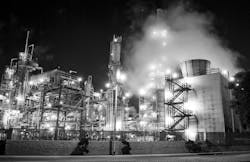Sustainability has become an increasingly larger topic of discussion among manufacturers of various types, including those in the fluid power and electronic motion control industries Power & Motion covers. Efforts to improve sustainability are taking many forms from reducing carbon emissions in manufacturing operations to designing products in a more sustainable manner to developing solutions that will help end-use customers reduce their environmental footprint, such as through the design of electric vehicles.
The rising focus on sustainability has come not only from increased concern over the environment but also the business benefits which can be achieved. Many technologies being developed today are aiming to improve efficiency, which can help to reduce energy use — and thus costs — and emissions, while also helping to improve productivity.
Volvo Construction Equipment has stated seeing great value in electrification due to growing interest it sees in the market for electric-powered machines. As such, it will continue to invest in the development of such machines while also setting out targets to reduce carbon emissions from its own operations which its sees as a societal need.
Reducing Emissions in Manufacturing
Producing components, machines and other goods in a more sustainable manner is an area in which many manufacturers are focusing their efforts. According to the U.S. Department of Energy (DOE), the United States' industrial sector accounts for one-third of all energy-related greenhouse gas (GHG) emissions produced in the region. It is also one of the more difficult industries to decarbonize.
As such, the Biden-Harris administration has made decarbonizing the industrial sector a key part of its sustainability goals. Various DOE funding opportunities have been created to help achieve the President's goal of moving the country toward a net-zero emissions economy by 2050.
Most recently, the DOE announced $135 million in funding would be given to 40 projects focused on reducing carbon emissions from manufacturing operations. The projects are in line with the DOE's Industrial Decarbonization Roadmap which outlines some of the key ways in which emissions can be reduced from the sector with a focus on the five most energy-intensive subsectors — cement and concrete, chemicals, food and beverage, iron and steel, and petroleum refining.
Projects receiving funding will be led by 36 different U.S. universities, National Laboratories, and companies. The DOE states in its press release announcing the funding that the projects will support research, development, and pilot-scale demonstrations to reduce energy usage and emissions from these subsectors which account for over 50% of the energy-related carbon dioxide (CO2) emissions in the industrial sector, as well as paper and forest products.
As part of its efforts to reduce carbon emissions from its operations, mining OEM Epiroc is working together with steel manufacturer SSAB to trial the use of metal additive manufacturing (AM) using SSAB's fossil-free steel. The companies are currently exploring how both the use of AM and the steel can reduce the environmental impact of producing a hydraulic block utilized in an Epiroc mining rock drill.
SSAB began developing a method of producing steel in a more sustainable manner in 2016, and in 2021 manufactured the first pieces of steel using its fossil-free method. Traditionally, coking coal is used to produce the iron-ore based steel. SSAB, however, has developed a way to manufacture its steel using fossil-free electricity and hydrogen in place of the coal which the company says virtually eliminates CO2 emissions from the production process.
Developing More Efficient Transportation Solutions
Trucking is another vital economic sector which produces a large amount of emissions. Several OEMs in this space, as well as component and system suppliers, are working on ways to reduce the carbon intensity of the sector such as development of battery-electric and hydrogen fuel cell powered trucks.
Another key area is making heavy-duty trucks more efficient through improvements to the engine and other design aspects. The more efficiently the trucks can operation, the less fuel used and emissions produced. Developments in these areas have the potential to be brought to market faster, compared to development of an alternatively powered vehicle, which enables sustainability benefits to be achieved in the near term.
In 2009, the DOE initiated its SuperTruck program focused on improving freight efficiency. It brings together teams of truck OEMs and component suppliers to meet the program's efficiency targets through design improvements to aerodynamics, vehicle weight reductions as well as use of new technologies — many of which have now become available in the market due to the benefits shown during the project.
The first iteration of SuperTruck tasked the teams with improving heavy-duty freight efficiency by 50% which all of the teams met or exceeded. SuperTruck II began in 2016 and challenged teams to double the efficiency of Class 8 trucks.
Recently truck manufacturer Navistar announced its truck design for the SuperTruck II program demonstrated a 170% improvement in freight efficiency over its SuperTruck I design and 16 mpg fuel efficiency. The company's truck was able to achieve these through the use of hybridization, aerodynamic improvements and weight reductions made possible through advancements in rolling resistance technologies.
A third iteration of the SuperTruck program was announced in April 2021 with a focus this time on both medium- and heavy-duty truck technologies which will include electrification and hydrogen solutions.
With efforts such as these, and so many more, its clear there is a real desire to design, manufacture and operate products in a more sustainable manner. Much yet needs to be done, but the fact there are efforts being made demonstrates the importance of this topic as well as the innovative nature of the engineering industry to develop technologies and methods for reaching emissions reduction targets.
We want to hear from you!
What sustainability efforts are you seeing in the industry? How do you foresee these efforts continuing to progress in the coming years? What technologies do you see being the most beneficial to sustainability efforts?
Let us know! Reach out directly via email [email protected] or on social media.
Twitter: @TechnlgyEditor or @PowerMotionTech
LinkedIn: @PowerMotionTech



